TOYOTA PRIUS PLUG-IN 2013 Owners Manual
Manufacturer: TOYOTA, Model Year: 2013, Model line: PRIUS PLUG-IN, Model: TOYOTA PRIUS PLUG-IN 2013Pages: 704, PDF Size: 19.59 MB
Page 201 of 704
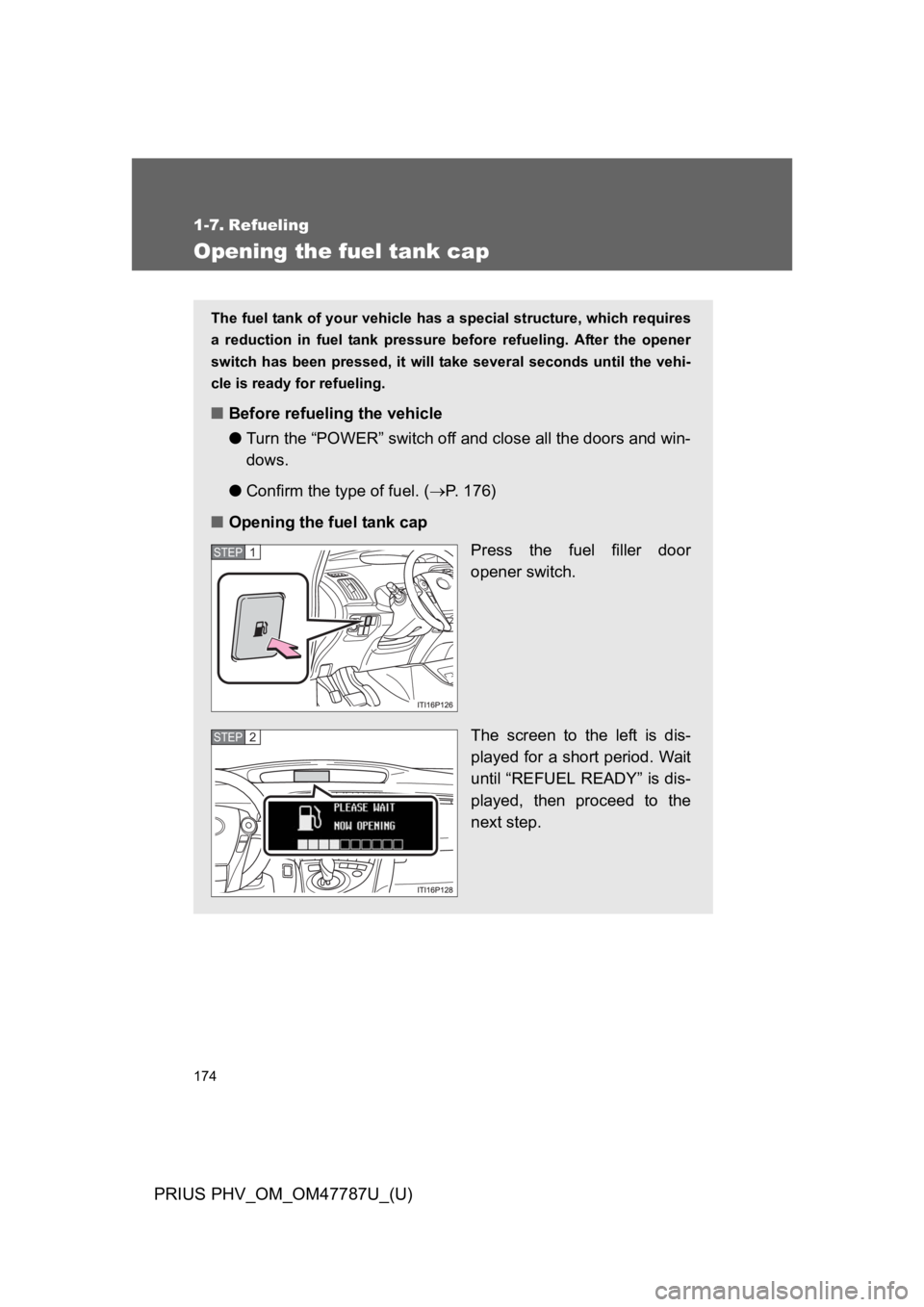
174
PRIUS PHV_OM_OM47787U_(U)
1-7. Refueling
Opening the fuel tank cap
The fuel tank of your vehicle has a special structure, which requires
a reduction in fuel tank pressure before refueling. After the opener
switch has been pressed, it will take several seconds until the vehi-
cle is ready for refueling.
■Before refueling the vehicle
●Turn the “POWER” switch off and close all the doors and win-
dows.
●Confirm the type of fuel. (→P. 1 7 6 )
■Opening the fuel tank cap
Press the fuel filler door
opener switch.
The screen to the left is dis-
played for a short period. Wait
until “REFUEL READY” is dis-
played, then proceed to the
next step.
STEP 1
STEP 2
Page 202 of 704
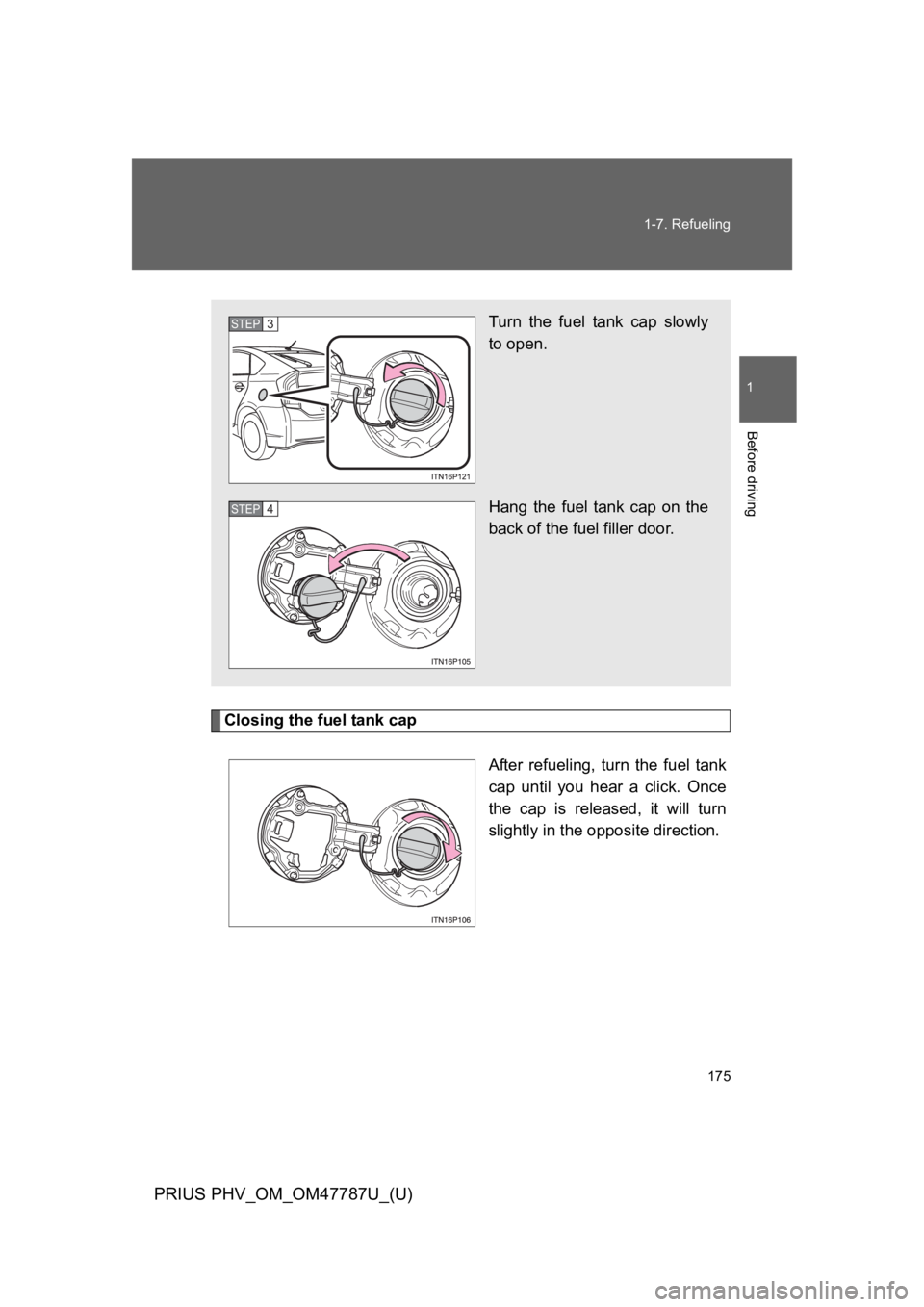
175
1-7. Refueling
1
Before driving
PRIUS PHV_OM_OM47787U_(U)
Closing the fuel tank cap
After refueling, turn the fuel tank
cap until you hear a click. Once
the cap is released, it will turn
slightly in the opposite direction.
Turn the fuel tank cap slowly
to open.
Hang the fuel tank cap on the
back of the fuel filler door.
STEP 3
STEP 4
Page 203 of 704
![TOYOTA PRIUS PLUG-IN 2013 Owners Manual 176
1-7. Refueling
PRIUS PHV_OM_OM47787U_(U)
■Fuel types
Use unleaded gasoline. (Octane rating 87 [Research Octane Number 91] or
higher)
■If the fuel filler door opener is inoperable
If the fuel TOYOTA PRIUS PLUG-IN 2013 Owners Manual 176
1-7. Refueling
PRIUS PHV_OM_OM47787U_(U)
■Fuel types
Use unleaded gasoline. (Octane rating 87 [Research Octane Number 91] or
higher)
■If the fuel filler door opener is inoperable
If the fuel](/img/14/58478/w960_58478-202.png)
176
1-7. Refueling
PRIUS PHV_OM_OM47787U_(U)
■Fuel types
Use unleaded gasoline. (Octane rating 87 [Research Octane Number 91] or
higher)
■If the fuel filler door opener is inoperable
If the fuel filler door opener switch cannot be operated, contact your Toyota
dealer. In the event that urgent refueling is required, follow the procedure
below.
Remove the cap slowly. Take care to prevent fuel from spilling
out, as fuel tank pressure may not have been adequately
reduced.
Fill the fuel tank carefully and slowly. Use caution, as air being
discharged from inside the fuel tank may cause fuel to spray out
from the filler opening during refueling.
Open the fuel filler door using the lever in
the luggage compartment.STEP 1
STEP 2
STEP 3
Page 204 of 704
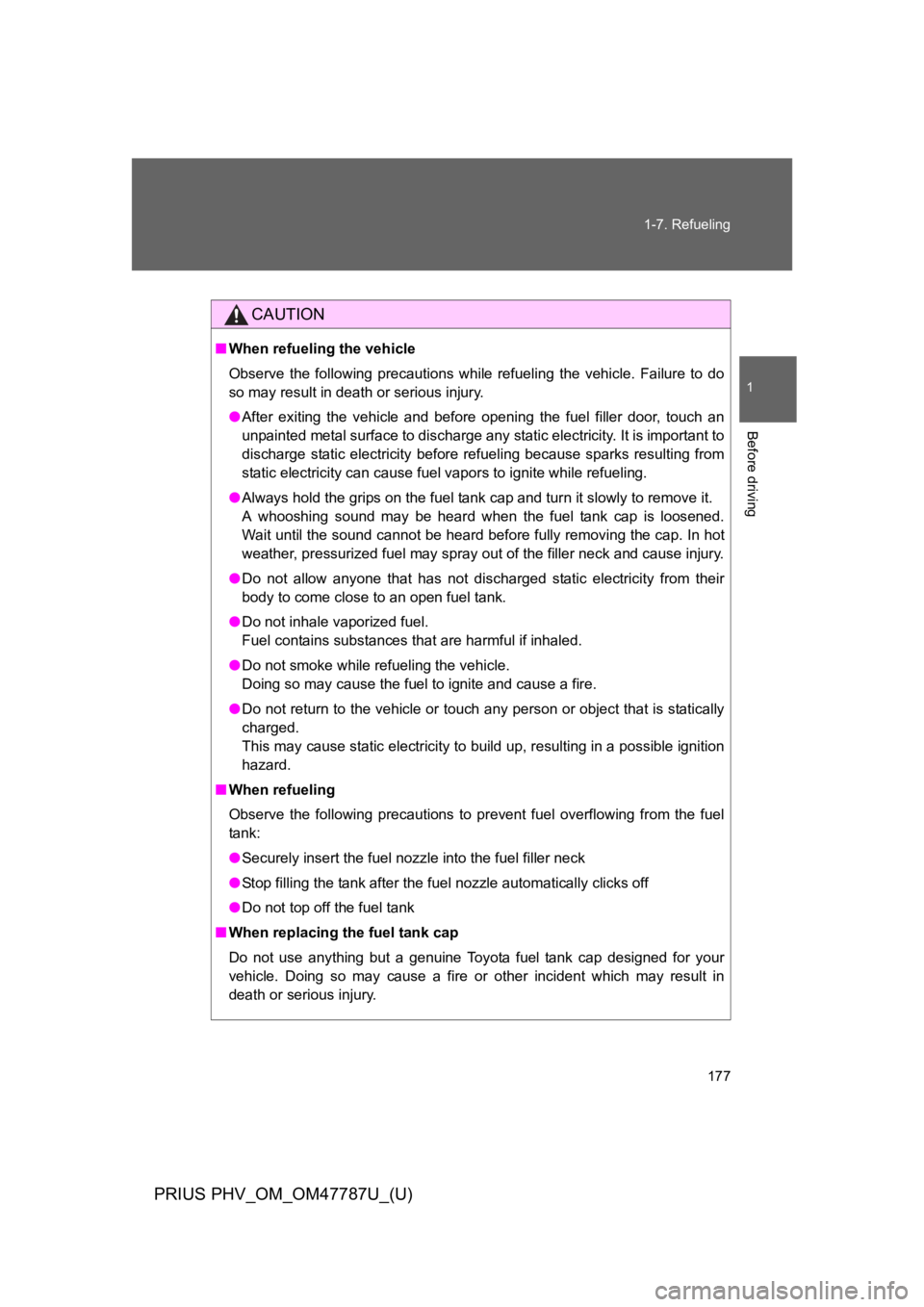
177
1-7. Refueling
1
Before driving
PRIUS PHV_OM_OM47787U_(U)
CAUTION
■When refueling the vehicle
Observe the following precautions while refueling the vehicle. Failure to do
so may result in death or serious injury.
●After exiting the vehicle and before opening the fuel filler door, touch an
unpainted metal surface to discharge any static electricity. It is important to
discharge static electricity before refueling because sparks resulting from
static electricity can cause fuel vapors to ignite while refueling.
●Always hold the grips on the fuel tank cap and turn it slowly to remove it.
A whooshing sound may be heard when the fuel tank cap is loosened.
Wait until the sound cannot be heard before fully removing the cap. In hot
weather, pressurized fuel may spray out of the filler neck and cause injury.
●Do not allow anyone that has not discharged static electricity from their
body to come close to an open fuel tank.
●Do not inhale vaporized fuel.
Fuel contains substances that are harmful if inhaled.
●Do not smoke while refueling the vehicle.
Doing so may cause the fuel to ignite and cause a fire.
●Do not return to the vehicle or touch any person or object that is statically
charged.
This may cause static electricity to build up, resulting in a possible ignition
hazard.
■When refueling
Observe the following precautions to prevent fuel overflowing from the fuel
tank:
●Securely insert the fuel nozzle into the fuel filler neck
●Stop filling the tank after the fuel nozzle automatically clicks off
●Do not top off the fuel tank
■When replacing the fuel tank cap
Do not use anything but a genuine Toyota fuel tank cap designed for your
vehicle. Doing so may cause a fire or other incident which may result in
death or serious injury.
Page 205 of 704
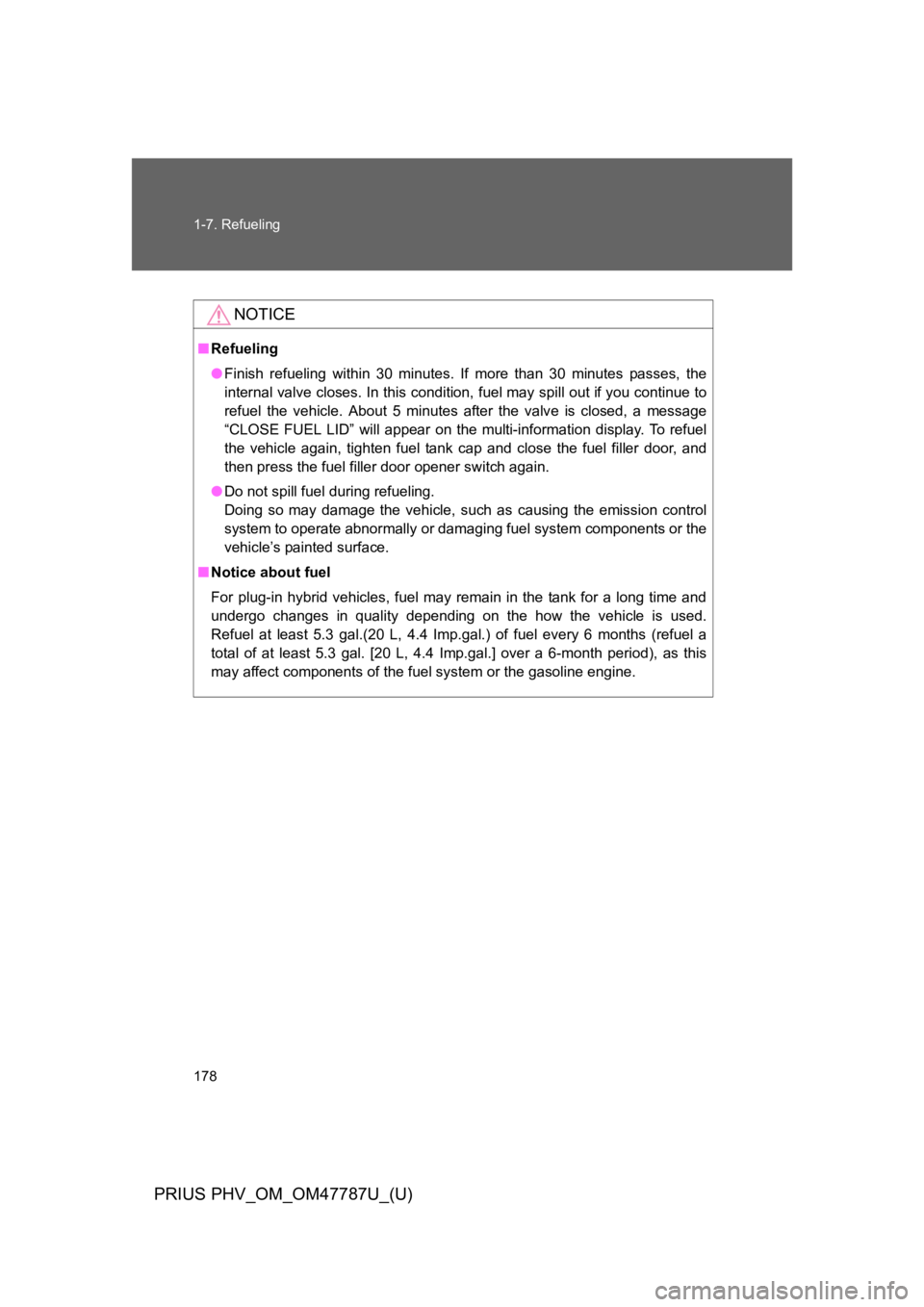
178
1-7. Refueling
PRIUS PHV_OM_OM47787U_(U)
NOTICE
■Refueling
●Finish refueling within 30 minutes. If more than 30 minutes passes, the
internal valve closes. In this condition, fuel may spill out if you continue to
refuel the vehicle. About 5 minutes after the valve is closed, a message
“CLOSE FUEL LID” will appear on the multi-information display. To refuel
the vehicle again, tighten fuel tank cap and close the fuel filler door, and
then press the fuel filler door opener switch again.
●Do not spill fuel during refueling.
Doing so may damage the vehicle, such as causing the emission control
system to operate abnormally or damaging fuel system components or the
vehicle’s painted surface.
■Notice about fuel
For plug-in hybrid vehicles, fuel may remain in the tank for a long time and
undergo changes in quality depending on the how the vehicle is used.
Refuel at least 5.3 gal.(20 L, 4.4 Imp.gal.) of fuel every 6 months (refuel a
total of at least 5.3 gal. [20 L, 4.4 Imp.gal.] over a 6-month period), as this
may affect components of the fuel system or the gasoline engine.
Page 206 of 704
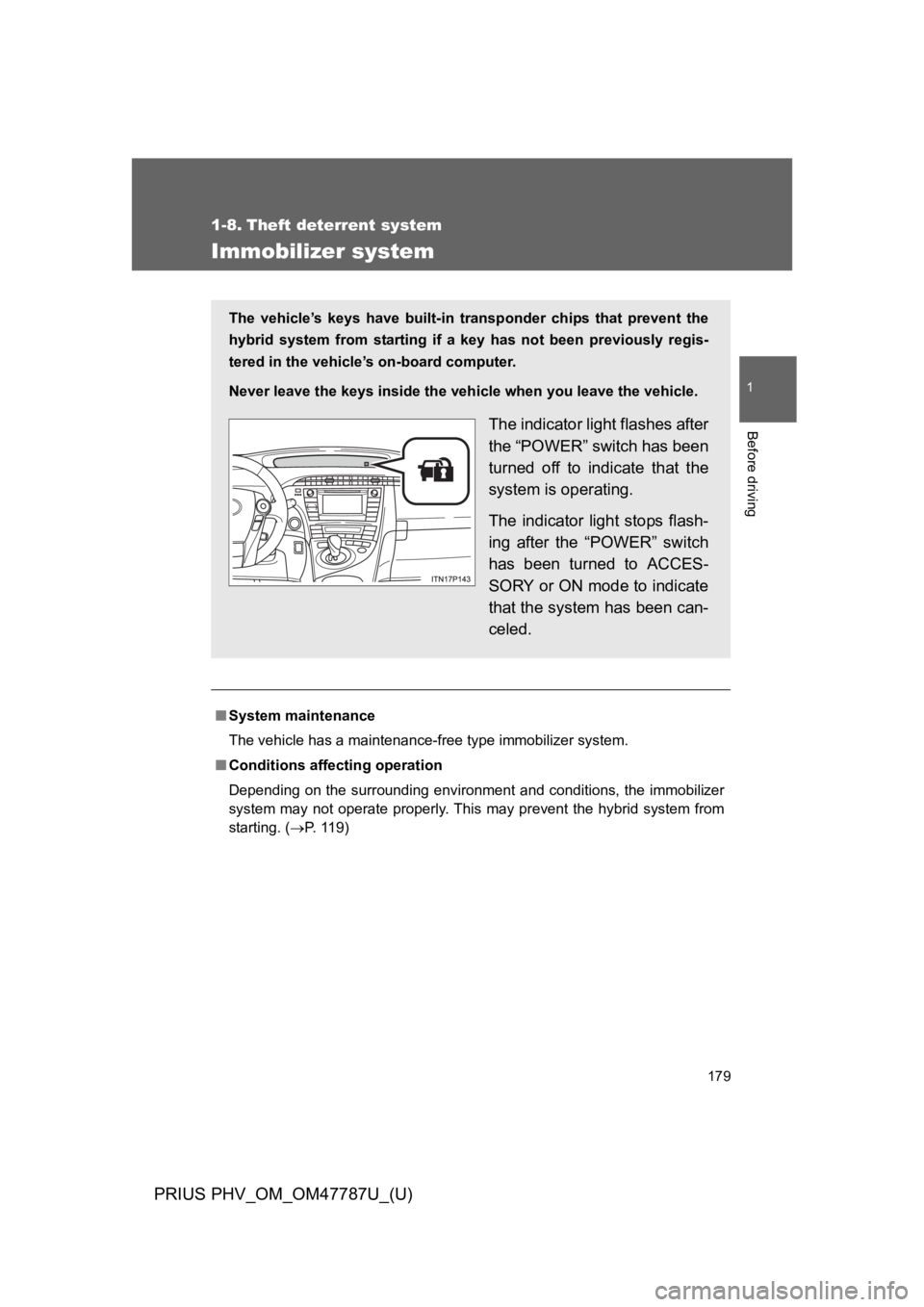
179
1
Before driving
PRIUS PHV_OM_OM47787U_(U)
1-8. Theft deterrent system
Immobilizer system
■System maintenance
The vehicle has a maintenance-free type immobilizer system.
■Conditions affecting operation
Depending on the surrounding environment and conditions, the immobilizer
system may not operate properly. This may prevent the hybrid system from
starting. (→P. 1 1 9 )
The vehicle’s keys have built-in transponder chips that prevent the
hybrid system from starting if a key has not been previously regis-
tered in the vehicle’s on-board computer.
Never leave the keys inside the vehicle when you leave the vehicle.
The indicator light flashes after
the “POWER” switch has been
turned off to indicate that the
system is operating.
The indicator light stops flash-
ing after the “POWER” switch
has been turned to ACCES-
SORY or ON mode to indicate
that the system has been can-
celed.
Page 207 of 704

180
1-8. Theft deterrent system
PRIUS PHV_OM_OM47787U_(U)
■Certifications for the immobilizer system
For vehicles sold in the U.S.A.
FCC ID: NI4TMIMB-1
This device complies with Part 15 of the FCC Rules. Operation is subject to
the following two conditions: (1) this device may not cause harmful interfer-
ence, and (2) this device must accept any interference received, including
interference that may cause undesired operation.
FCC WARNING:
Changes or modifications not expressly approved by the party responsible
for compliance could void the user’s authority to operate the equipment.
For vehicles sold in Canada
Operation is subject to the following two conditions: (1) this device may not
cause interference, and (2) this device must accept any interference, includ-
ing interference that may cause undesired operation of the device.
Page 208 of 704
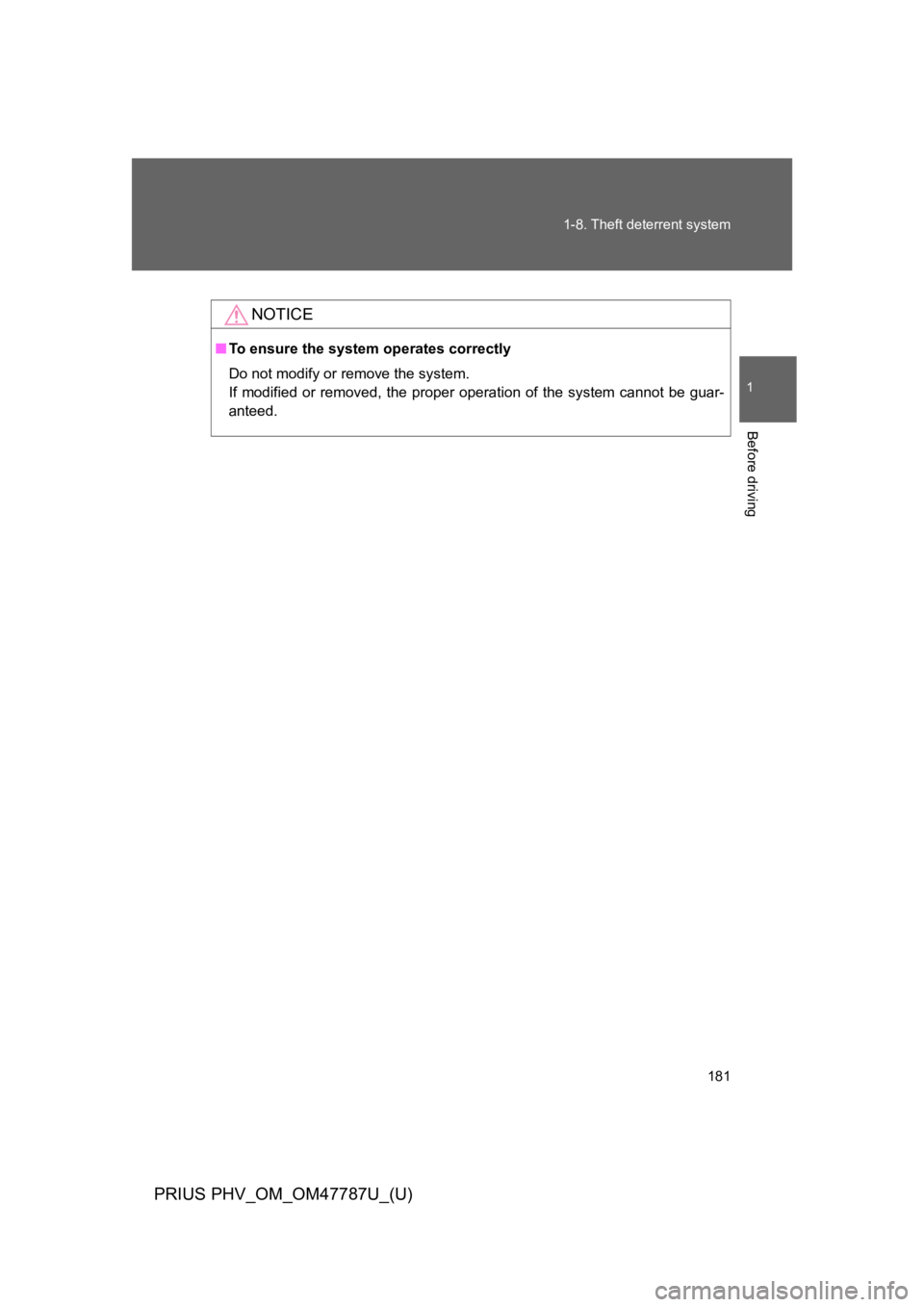
181
1-8. Theft deterrent system
1
Before driving
PRIUS PHV_OM_OM47787U_(U)
NOTICE
■To e n s u r e t h e s y s t e m o p e r a t e s c o r r e c t l y
Do not modify or remove the system.
If modified or removed, the proper operation of the system cannot be guar-
anteed.
Page 209 of 704
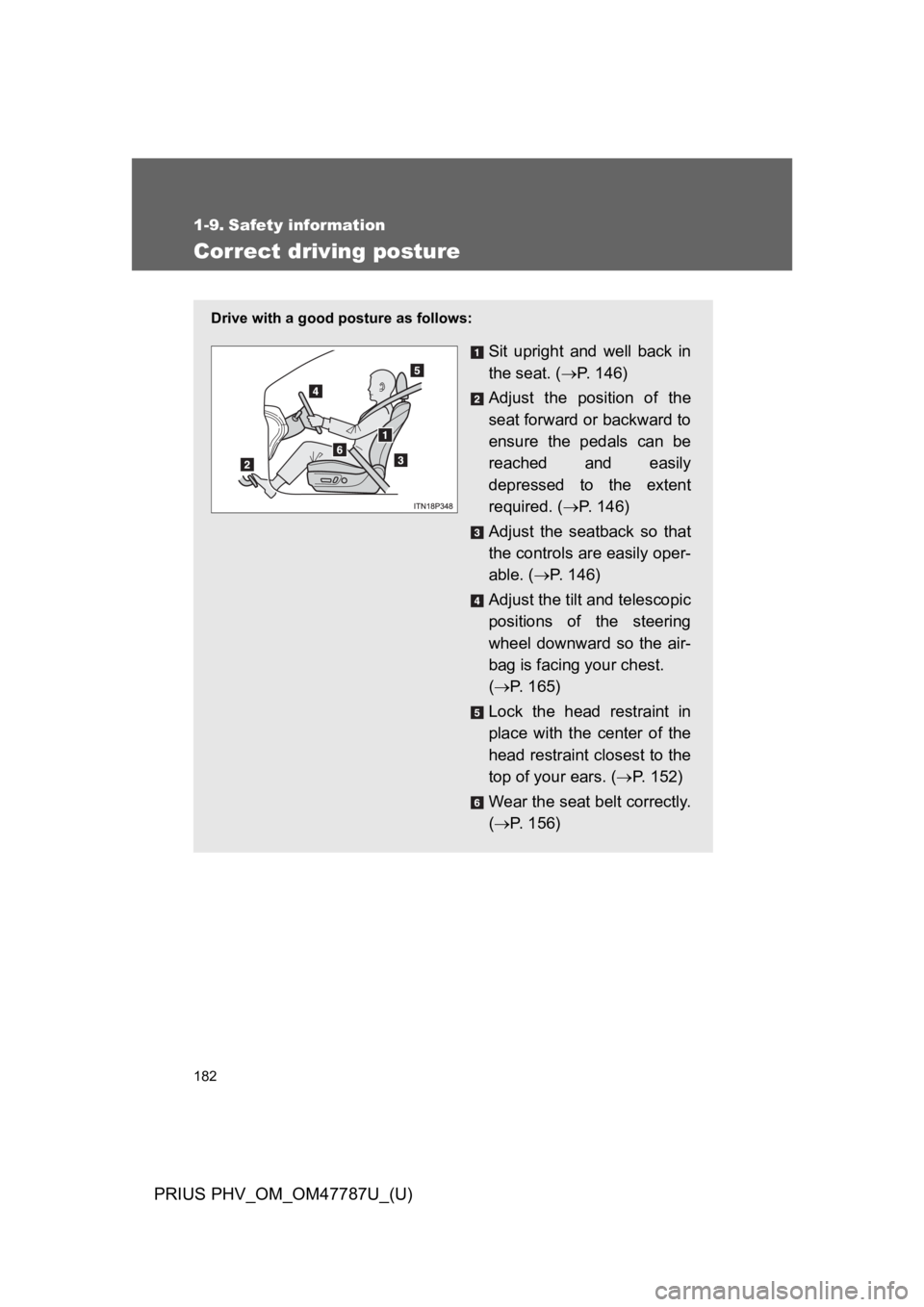
182
PRIUS PHV_OM_OM47787U_(U)
1-9. Safety information
Correct driving posture
Drive with a good posture as follows:
Sit upright and well back in
the seat. (→P. 1 4 6 )
Adjust the position of the
seat forward or backward to
ensure the pedals can be
reached and easily
depressed to the extent
required. (→P. 1 4 6 )
Adjust the seatback so that
the controls are easily oper-
able. (→P. 1 4 6 )
Adjust the tilt and telescopic
positions of the steering
wheel downward so the air-
bag is facing your chest.
(→P. 1 6 5 )
Lock the head restraint in
place with the center of the
head restraint closest to the
top of your ears. (→P. 1 5 2 )
Wear the seat belt correctly.
(→P. 1 5 6 )
Page 210 of 704
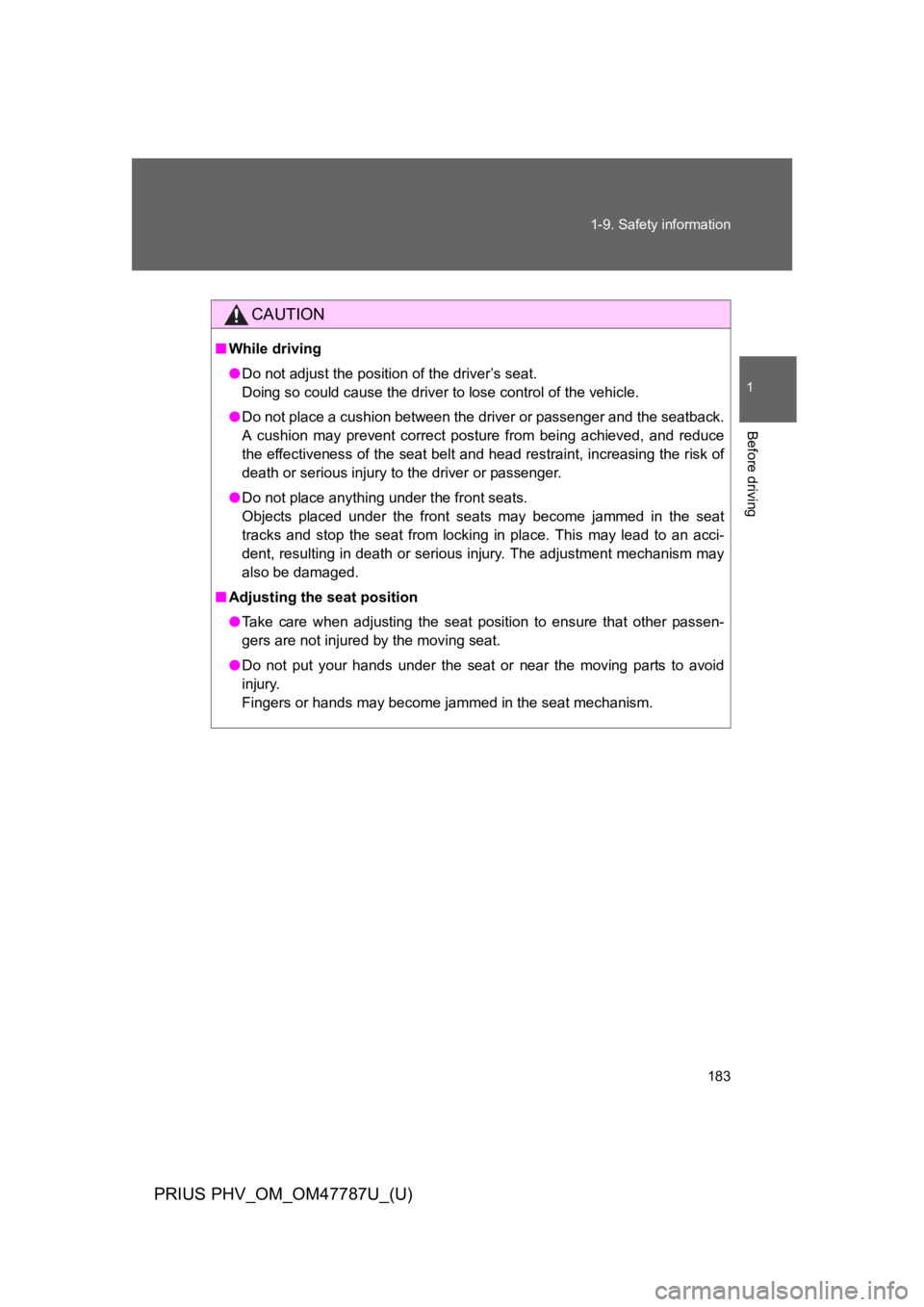
183
1-9. Safety information
1
Before driving
PRIUS PHV_OM_OM47787U_(U)
CAUTION
■While driving
●Do not adjust the position of the driver’s seat.
Doing so could cause the driver to lose control of the vehicle.
●Do not place a cushion between the driver or passenger and the seatback.
A cushion may prevent correct posture from being achieved, and reduce
the effectiveness of the seat belt and head restraint, increasing the risk of
death or serious injury to the driver or passenger.
●Do not place anything under the front seats.
Objects placed under the front seats may become jammed in the seat
tracks and stop the seat from locking in place. This may lead to an acci-
dent, resulting in death or serious injury. The adjustment mechanism may
also be damaged.
■Adjusting the seat position
●Ta k e c a r e w h e n a d j u s t i n g t h e s e a t p o s i t i o n t o e n s u r e t h a t o t h e r p a s s e n -
gers are not injured by the moving seat.
●Do not put your hands under the seat or near the moving parts to avoid
injury.
Fingers or hands may become jammed in the seat mechanism.